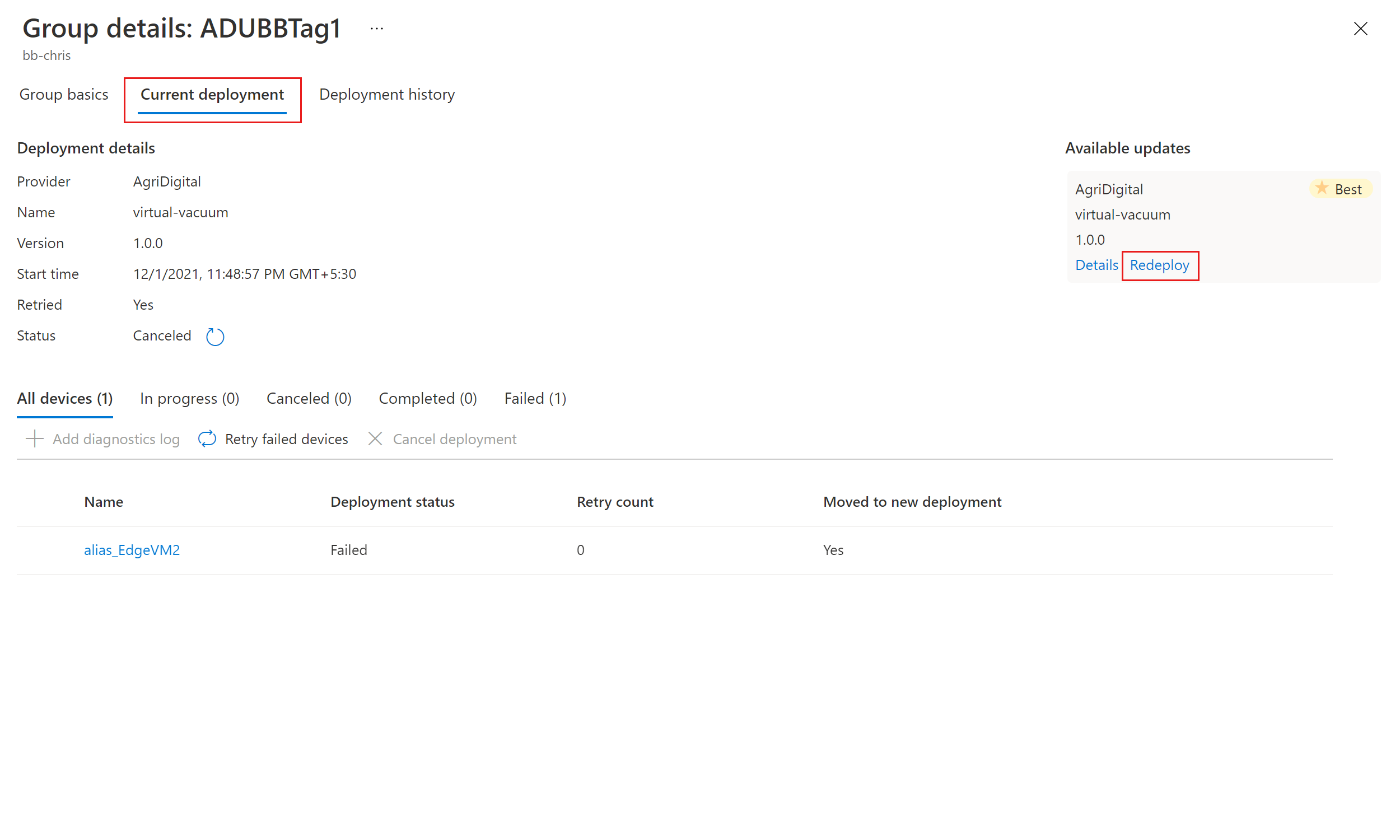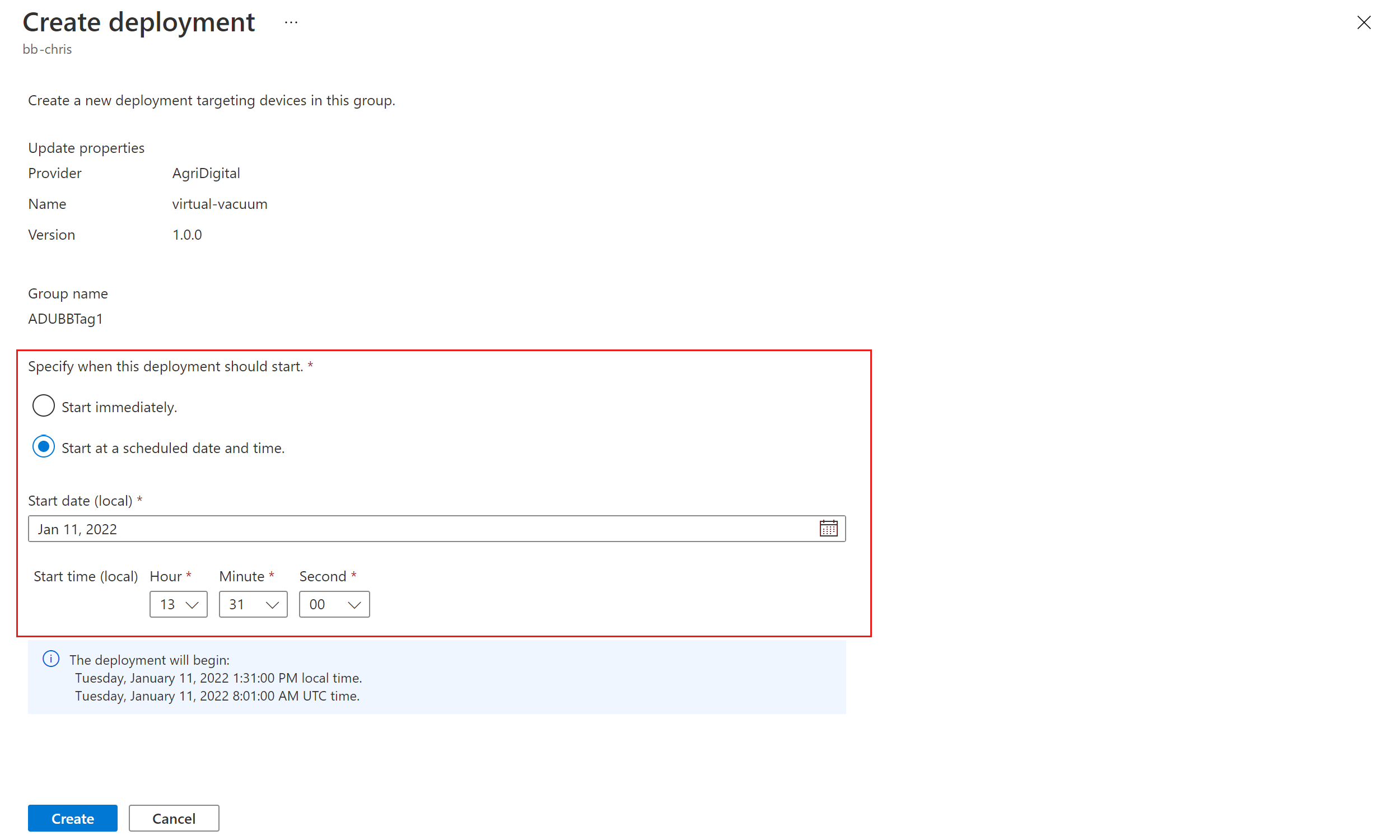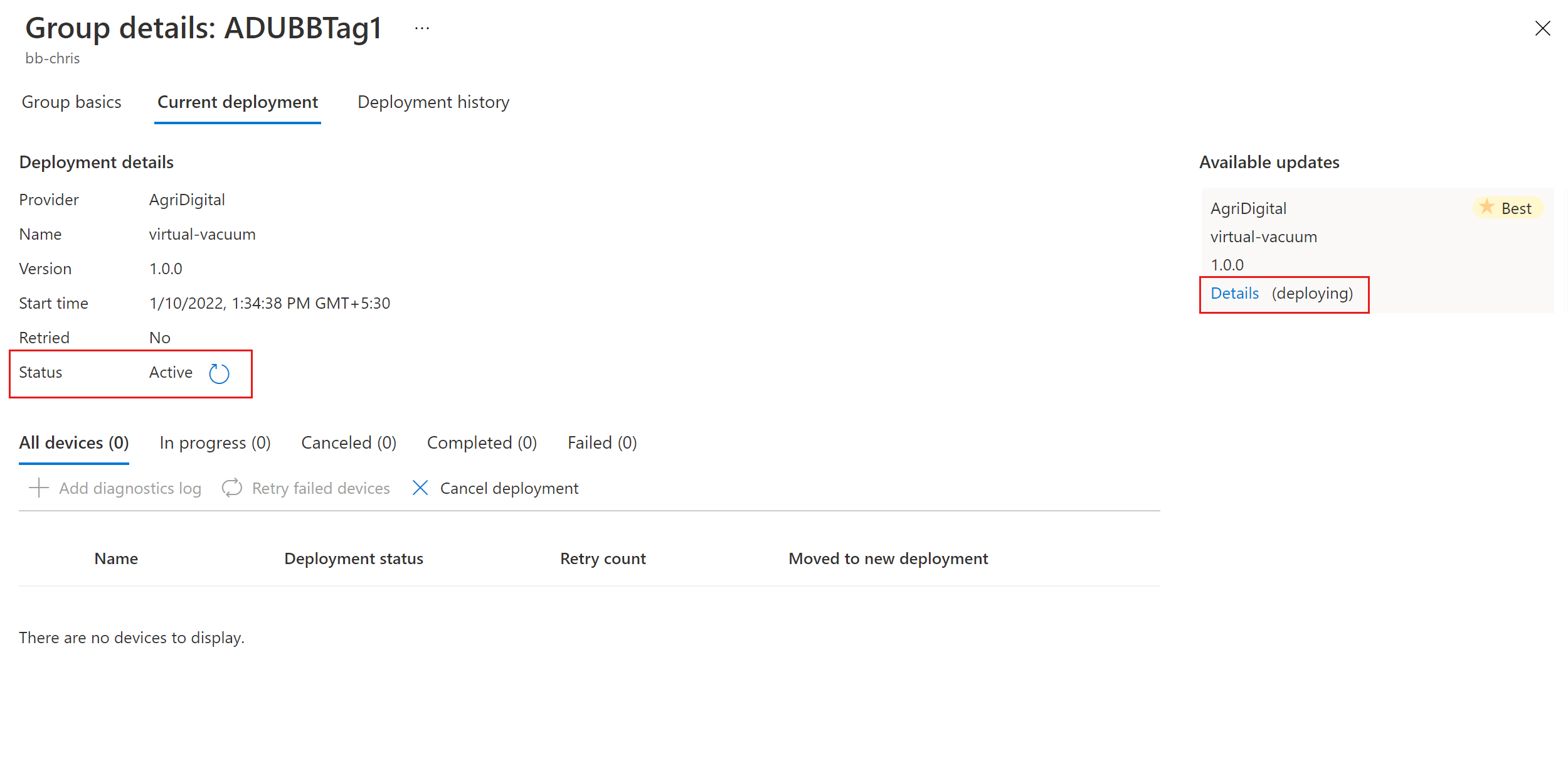Tutorial: Azure Device Update for IoT Hub using the Ubuntu 22.04 package agent
Device Update for Azure IoT Hub supports image-based, package-based, and script-based updates. This tutorial demonstrates an end-to-end package update using the Device Update Ubuntu Server 22.04 x64 package agent to update Azure IoT Edge.
Package-based updates are targeted to alter only a specific device component or application. These updates have lower bandwidth consumption and shorter download and install times than image-based updates, incurring less device downtime and avoiding the overhead of creating images. In a package-based update, an APT manifest provides the Device Update agent the information it needs to download and install specified packages and their dependencies from a designated repository.
This tutorial walks you through installing Microsoft Defender for IoT, but you can update other packages by using similar steps, such as IoT Edge itself or the container engine it uses. The tools and concepts in this tutorial apply even if you use a different OS platform configuration.
In this tutorial, you:
- Download and install the Device Update agent and its dependencies.
- Add a group tag to your device.
- Import the package update.
- Deploy the package update.
- View the update deployment history.
Prerequisites
- A Device Update account and instance configured with an IoT hub.
- An Azure IoT Edge device registered in the IoT hub with the connection string copied.
Prepare the device
For convenience, this tutorial uses a cloud-init based Azure Resource Manager (ARM) template to quickly set up an Ubuntu 22.04 LTS virtual machine (VM). The template installs both the IoT Edge runtime and the Device Update package agent, and automatically configures the device with provisioning information by using the IoT Edge device connection string you supply. Using the ARM template also avoids the need to start a secure shell (SSH) session to complete setup.
To run the template, select the following Deploy to Azure button:
Complete the following information:
- Subscription: The active Azure subscription to deploy the VM into.
- Resource group: An existing or new resource group to contain the VM and its resources.
- Region: The geographic region to deploy the VM into, which defaults to the location of the resource group.
- Dns Label Prefix: A value to prefix the hostname of the VM.
- Admin Username: A username to provide with root privileges at deployment.
- Authentication Type: Choose sshPublicKey or password.
- Admin Password or SSH public key source, SSH Key Type, Key pair name: The password or SSH public key information based on the choice of authentication type.
- VM Size: The size of the VM to deploy.
- Ubuntu OS Version: Leave at 22_04-lts.
- Device Connection String: The IoT Edge connection string you copied previously.
Select Review + create at the bottom of the page. When validation succeeds, select Create to begin the template deployment.
Verify that the deployment completes successfully, and allow a few minutes after deployment completes for the post-installation and configuration to finish installing IoT Edge and the device package update agent.
You should see a VM resource in the selected resource group. Note the machine name, which is in the format
vm-0000000000000. Select the VM name, and on the VM Overview page, note the DNS name, which is in the format<dnsLabelPrefix>.<location>.cloudapp.azure.com.
Tip
To SSH into this VM after setup, use the associated DNS name with the command ssh <admin username>@<DNS name>.
Install the Device Update agent on the VM
Important
Azure Device Update for IoT Hub software is subject to the following license terms:
Read the license terms before using the agent. Agent installation and use constitutes acceptance of these terms. If you don't agree with the license terms, don't use the Device Update agent.
To install the Device Update agent on the VM, run the following command.
sudo apt-get install deviceupdate-agentOpen the du-config.json configuration details file by using the following command.
sudo nano /etc/adu/du-config.jsonIn the file, replace all
<placeholder>values with your own configuration. Set yourconnectionTypeas"AIS"andconnectionDataas an empty string. For an example file, see Example du-config.json file contents.Restart the Device Update agent by running the following command.
sudo systemctl restart deviceupdate-agent
Note
If you used the simulator agent on this device previously, run the following command to invoke the APT handler and deploy over-the-air package updates for this tutorial.
sudo /usr/bin/AducIotAgent --register-content-handler /var/lib/adu/extensions/sources/libmicrosoft_apt_1.so --update-type 'microsoft/apt:1'
Add a group tag to your device
Device Update automatically organizes devices into groups based on their assigned tags and compatibility properties. Each device can belong to only one group, but groups can have multiple subgroups to sort different device classes. For more information about tags and groups, see Manage device groups.
On the Azure portal IoT hub page for your Device Update instance, select Device management > Devices from the left navigation.
Go to the Device twin or Module Identity twin for your device.
In the device twin or Device Update agent Module Identity Twin file, delete any existing Device Update tag values by setting them to
null, and then add the following new Device Update group tag.If you're using device identity with the Device Update agent, make these changes on the device twin. If you're using a module identity with the Device Update agent module, add the tag in the Module Identity Twin.
"tags": { "ADUGroup": "<GroupTagValue>" },The following screenshot shows where in the file to add the tag.

Select Save.
Import the update
The Tutorial_IoTEdge_PackageUpdate.zip file has the required files for the tutorial.
Download the Tutorial_IoTEdge_PackageUpdate.zip file from the Assets section of the latest release on the GitHub Device Update Releases page.
Unzip the file. The extracted Tutorial_IoTEdge_PackageUpdate folder contains the sample-defender-iot-apt-manifest.json sample APT manifest and its corresponding sample-defender-iot--importManifest.json import manifest.
On the Azure portal IoT hub page for your Device Update instance, select Device Management > Updates from the left navigation.
On the Updates page, select Import a new update.
On the Import update page, select Select from storage container.
On the Storage accounts page, select an existing storage account or create a new account by selecting Storage account.
On the Containers page, select an existing container or create a new container by selecting Container. You use the container to stage the update files for import.

Tip
To avoid accidentally importing files from previous updates, use a new container each time you import an update. If you don't use a new container, be sure to delete any files from the existing container.
On the container page, select Upload, drag and drop or browse to and select the update files you downloaded, and then select Upload. After they upload, the files appear on the container page.
Review and select the files to import, and then select Select.

On the Import update screen, select Import update.

The import process begins, and the screen switches to the Updates screen. After the import succeeds, it appears on the Updates tab. For more information about the import process, see Import an update to Device Update.

Select the device group
You can use the group tag you applied to your device to deploy the update to the device group. Select the Groups and Deployments tab at the top of the Updates page to view the list of groups and deployments and the update compliance chart.
The update compliance chart shows the count of devices in various states of compliance: On latest update, New updates available, and Updates in progress. For more information, see Device Update compliance.
Under Group name, you see a list of all the device groups for devices connected to this IoT hub and their available updates, with links to deploy the updates under Status. Any devices that don't meet the device class requirements of a group appear in a corresponding invalid group. For more information about tags and groups, see Manage device groups.
You should see the device group that contains the device you set up in this tutorial, along with the available updates for the devices in the group. You might need to refresh the page. To deploy the best available update to the group from this view, select Deploy next to the group.
Deploy the update
On the Group details page, select the Current deployment tab and then select Deploy next to the desired update in the Available updates section. The best available update for the group is denoted with a Best highlight.
On the Create deployment page, schedule your deployment to start immediately or in the future, and then select Create.
Tip
By default, the Start date and time is 24 hours from your current time. Be sure to select a different date and time if you want the deployment to begin sooner.
On the Group details page under Deployment details, Status turns to Active. Under Available updates, the selected update is marked with (deploying).
On the Groups and Deployments tab of the Updates page, view the compliance chart to see that the update is now in progress. After your device successfully updates, the compliance chart and deployment details update to reflect that status.
View update deployment history
Select the Deployment history tab at the top of the Group details page, and select the details link next to the deployment you created.
On the Deployment details page, select the Refresh icon to view the latest status details.
Clean up resources
When you no longer need the resources you created for this tutorial, you can delete them.
- In the Azure portal, navigate to the resource group that contains the resources.
- If you want to delete all the resources in the group, select Delete resource group.
- If you want to delete only some of the resources, use the check boxes to select the resources and then select Delete.







